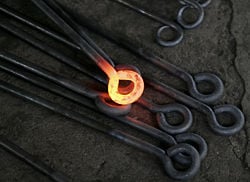Metal
- For alternative meanings see metal (disambiguation).
In chemistry, a metal (Greek: Metallon) is an element that readily forms ions (cations) and has metallic bonds, and metals are sometimes described as a lattice of positive ions (cations) in a cloud of electrons. The metals are one of the three groups of elements as distinguished by their ionization and bonding properties, along with the metalloids and nonmetals. On the periodic table, a diagonal line drawn from boron (B) to polonium (Po) separates the metals from the nonmetals. Elements on this line are metalloids, sometimes called semi-metals; elements to the lower left are metals; elements to the upper right are nonmetals.
Nonmetal elements are more abundant in nature than are metallic elements, but metals in fact constitute most of the periodic table. Some well-known metals are aluminium, copper, gold, iron, lead, silver, titanium, uranium, and zinc.
The allotropes of metals tend to be lustrous, ductile, malleable, and good conductors, while nonmetals generally speaking are brittle (for solid nonmetals), lack luster, and are insulators.
A more modern definition of metals is that they have overlapping conductance and valence bands in their electronic structure. This definition opens up the category for metallic polymers and other organic metals, which have been made by researchers and employed in high-tech devices. These synthetic materials often have the characteristic silvery-grey reflectiveness of elemental metals.
The properties of conductivity are mainly because each atom exerts only a loose hold on its outermost electrons (valence electrons); thus, the valence electrons form a sort of sea around the close-packed metal nucleii cations.
Most metals are chemically unstable, reacting with oxygen in the air to form oxides over varying timescales (iron rusts over years, potassium burns in seconds, silver tarnishes in months). The alkali metals react quickest followed by the alkaline earth metals, found in the leftmost two groups of the periodic table. The transition metals take much longer to oxidize (e.g. iron, copper, zinc, nickel), and palladium, platinum and gold do not react with atmospheric oxygen at all (which is why we make shiny jewelry from them). Some metals form a barrier layer of oxide on their surface which cannot be penetrated by further oxygen molecules and thus retain their shiny appearance and good conductivity for many decades (e.g. aluminium, some steels, titanium and more).
Painting or anodizing metals are good ways to prevent their oxidation.
Alloys
An alloy is a mixture with metallic properties that contains at least one metal element. Examples of alloys are steel (iron and carbon), brass (copper and zinc), bronze (copper and tin), and duralumin (aluminium and copper). Alloys specially designed for highly demanding applications, such as jet engines, may contain more than ten elements.
Physical properties
Traditionally, metals have certain characteristic physical properties: they are usually shiny (they have "lustre"), have a high density, are ductile and malleable, usually have a high melting point, are usually hard, and conduct electricity and heat well. However, this is mainly because the low density, soft, low melting point metals happen to be reactive and we rarely encounter them in their elemental, metallic form.
Metal oxides
The oxides of metals are basic; those of nonmetals are acidic.
Astronomy usage
In the specialized usage of astronomy and astrophysics, the term "metal" is often used to refer to any element other than hydrogen or helium. See metal-rich.
See also
- screening
- metallic bond
- Metal Working
bg:Метал ca:Metall cs:Kov da:Metal de:Metall et:Metall es:Metal eo:Metalo fr:Métal ko:금속 id:Logam it:Metallo he:מתכת ku:Lajwerd la:Metallum nl:Metaal nds:Metall ja:金属 pl:Metal (chemia) pt:Metal ru:Металлы simple:Metal fi:Metalli sv:Metall th:โลหะ zh:金属 sr:Метал
Credits
New World Encyclopedia writers and editors rewrote and completed the Wikipedia article in accordance with New World Encyclopedia standards. This article abides by terms of the Creative Commons CC-by-sa 3.0 License (CC-by-sa), which may be used and disseminated with proper attribution. Credit is due under the terms of this license that can reference both the New World Encyclopedia contributors and the selfless volunteer contributors of the Wikimedia Foundation. To cite this article click here for a list of acceptable citing formats.The history of earlier contributions by wikipedians is accessible to researchers here:
The history of this article since it was imported to New World Encyclopedia:
Note: Some restrictions may apply to use of individual images which are separately licensed.
